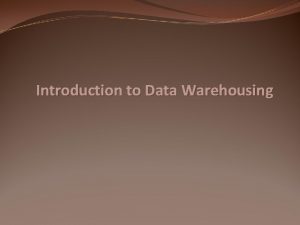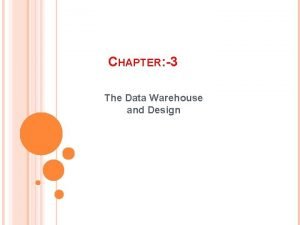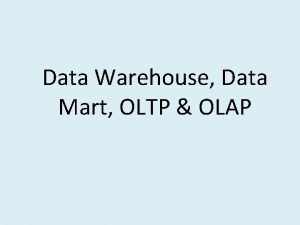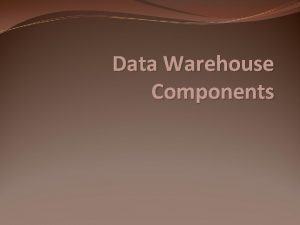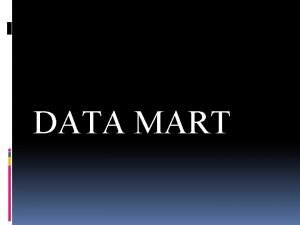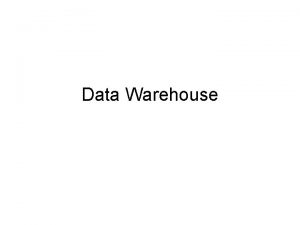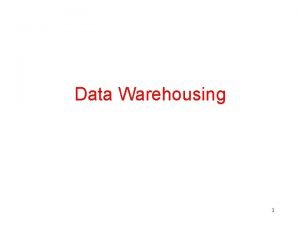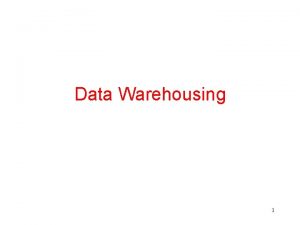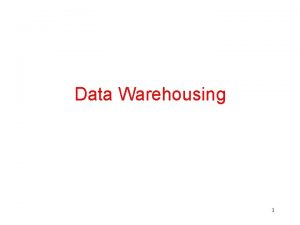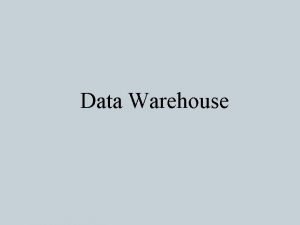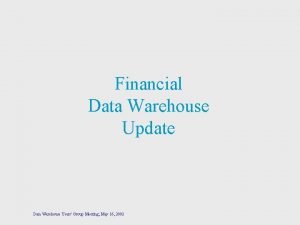INTORDUCTION DATA WAREHOUSE Mastering Data Warehouse and Design














- Slides: 14

INTORDUCTION DATA WAREHOUSE Mastering Data Warehouse and Design Relation and Dimensional Techniques Claudia Imhoff, Nicholas Galemmo, Jonathan G. Geiger Wiley Publishing, Inc. 2003,

Business Intelligence (BI) BI, in the context of the data warehouse, is the ability of an enterprise to study past behaviors and actions in order to understand where the organization has been, determine its current situation, and predict or change what will happen in the future

(continue) • Data warehousing is another good example of the adoption curve. • Today, the value of a sophisticated decision support environment is widely recognized throughout the business.

(continue) As an example, an effective customer relationship management program could not exist without strategic (data warehouse with associated marts) and a tactical (operational data store and oper mart) decision-making capabilities.

BI Architecture (EIS approach)

(continue) Two major groupings of components and processes: q Getting data in consists of the processes and databases involved in acquiring data from the operational systems, integrating it, cleaning it up, and putting it into a database for easy usage. The components of the CIF that are found in this function: Ø The operational system databases (source systems) Ø The data warehouse Ø The operational data Ø Data acquisition

(continue) q Getting information out consists of the processes and databases involved in delivering BI to the ultimate business consumer or analyst. The components of the CIF that are found in this function: Ø The data marts Ø The oper marts are derivatives of the Operational Data Store (ODS) Ø Data delivery is the process that moves data from the data warehouse into data and oper marts.

Role and Purpose of the Data Warehouse The data warehouse has been a part of the BI architecture from the very beginning.

(continue) Different methodologies and data warehouse have given this component various names such as: ØA staging area. A variation on the data warehouse is the “back office” staging area where data from the operational systems is first brought together. ØThe information warehouse. This was an early name for the data warehouseused by IBM and other vendors.

The Corporate Information Factory These information stores support three high-level organizational processes: ØBusiness operations are concerned with the ongoing day-to-day operations of the business. ØBusiness intelligence is concerned with the ongoing search for a better understanding of the company, of its products, and of its customers. ØBusiness management is the function in which the knowledge

The Multipurpose Nature of the Data Warehouse • It should be enterprise focused. • Its design should be as resilient to change as possible. • It should be designed to load massive amounts of data in very short amounts of time. • It should be designed for optimal data extraction processing by the data delivery programs. • Its data should be in a format that supports any and all possible BI analyses in any and all technologies.

Types of Data Marts Supported • • OLAP data mart. Exploration warehouse. Data-mining or statistical warehouse. Customizable analytical applications.

Types of BI Technologies Supported Business requirements—data mart design matrix.

Recommended Readings Chapter 1 Mastering Data Warehouse and Design Relation and Dimensional Techniques Claudia Imhoff, Nicholas Galemmo, Jonathan G. Geiger Wiley Publishing, Inc. 2003,
 Data warehousing data mining and olap
Data warehousing data mining and olap Introduction to data warehouse
Introduction to data warehouse Data warehouse physical design
Data warehouse physical design Physical design of data warehouse
Physical design of data warehouse Best practices data warehousing
Best practices data warehousing Mastering team skills and interpersonal communication
Mastering team skills and interpersonal communication Watch mastering conflict management and resolution at work
Watch mastering conflict management and resolution at work Watch mastering conflict management and resolution at work
Watch mastering conflict management and resolution at work Mastering conflict management and resolution at work
Mastering conflict management and resolution at work What is kdd process in data mining
What is kdd process in data mining Contoh data mart
Contoh data mart Data warehouse components
Data warehouse components Karakteristik data mart
Karakteristik data mart Arsitektur data mining
Arsitektur data mining Perbedaan data warehouse dan data mining
Perbedaan data warehouse dan data mining

